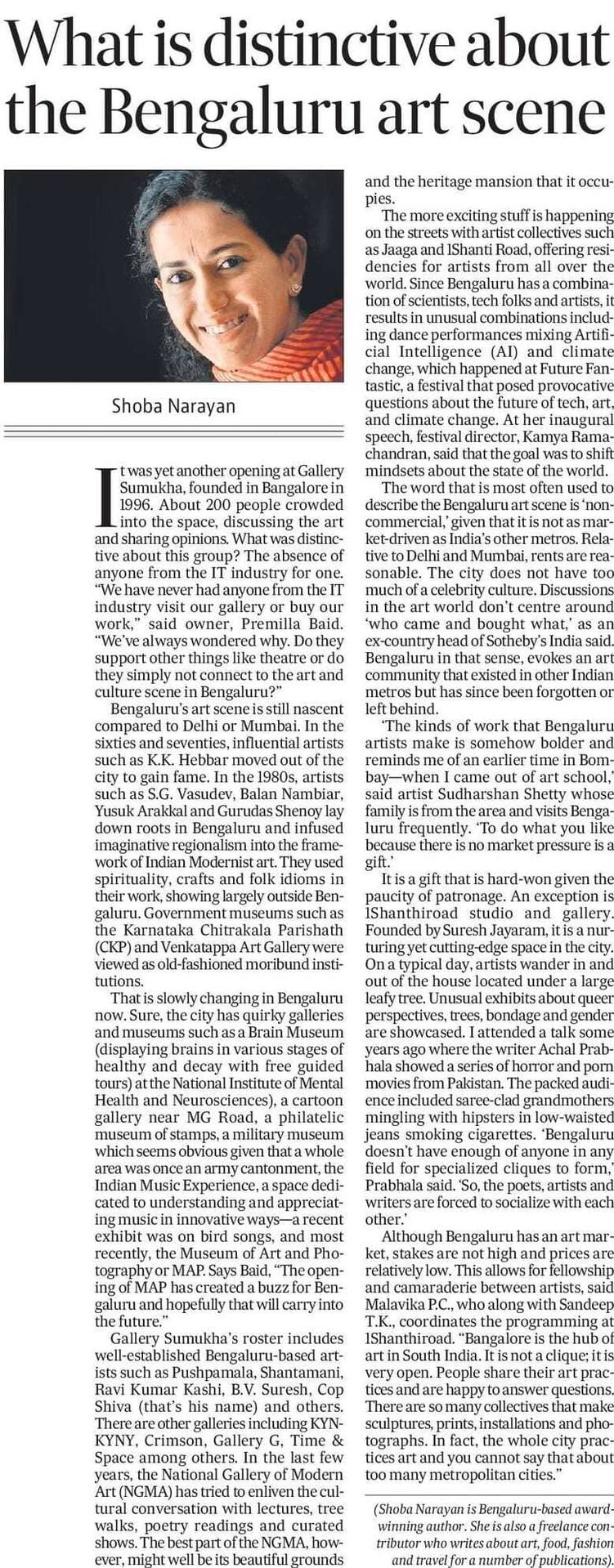It was yet another opening at Gallery Sumukha, founded in Bangalore in 1996. About 200 people crowded into the space, discussing the art and sharing opinions. What was distinctive about this group? The absence of anyone from the IT industry for one. “We have never had anyone from the IT industry visit our gallery or buy our work,” said owner, Premilla Baid. “We’ve always wondered why. Do they support other things like theatre or do they simply not connect to the art and culture scene in Bangalore?”
Bangalore’s art scene is still nascent compared to Delhi or Mumbai. In the sixties and seventies, influential artists such as K.K. Hebbar moved out of the city to gain fame. In the 1980s, artists such as S.G. Vasudev, Balan Nambiar, Yusuk Arakkal and Gurudas Shenoy lay down roots in Bangalore and infused imaginative regionalism into the framework of Indian Modernist art. They used spirituality, crafts and folk idioms in their work, showing largely outside Bangalore. Government museums such as the Karnataka Chitrakala Parishath (CKP) and Venkatappa Art Gallery were viewed as old-fashioned moribund institutions.
That is slowly changing in Bangalore now. Sure, the city has quirky galleries and museums such as a Brain Museum (displaying brains in various stages of healthy and decay with free guided tours) at the National Institute of Mental Health and Neurosciences), a cartoon gallery near MG Road, a philatelic museum of stamps, a military museum which seems obvious given that a whole area was once an army cantonment, the Indian Music Experience, a space dedicated to understanding and appreciating music in innovative ways—a recent exhibit was on bird songs, and most recently, the Museum of Art and Photography or MAP. Says Baid, “The opening of MAP has created a buzz for Bangalore and hopefully that will carry into the future.”
Gallery Sumukha’s roster includes well-established Bangalore-based artists such as Pushpamala, Shantamani, Ravi Kumar Kashi, B.V. Suresh, Cop Shiva (that’s his name) and others. There are other galleries including KYNKYNY, Crimson, Gallery G, Time & Space among others. In the last few years, the National Gallery of Modern Art (NGMA) has tried to enliven the cultural conversation with lectures, tree walks, poetry readings and curated shows. The best part of the NGMA, however, might well be its beautiful grounds and the heritage mansion that it occupies.
The more exciting stuff is happening on the streets with artist collectives such as Jaaga and 1Shanti Road, offering residencies for artists from all over the world. Since Bangalore has a combination of scientists, tech folks and artists, it results in unusual combinations including dance performances mixing Artificial Intelligence (AI) and climate change, which happened at Future Fantastic, a festival that posed provocative questions about the future of tech, art, and climate change. At her inaugural speech, festival director, Kamya Ramachandran, said that the goal was to shift mindsets about the state of the world.
The word that is most often used to describe the Bangalore art scene is ‘non-commercial,’ given that it is not as market-driven as India’s other metros. Relative to Delhi and Mumbai, rents are reasonable. The city does not have too much of a celebrity culture. Discussions in the art world don’t centre around ‘who came and bought what,’ as an ex-country head of Sotheby’s India said. Bangalore in that sense, evokes an art community that existed in other Indian metros but has since been forgotten or left behind.
‘The kinds of work that Bangalore artists make is somehow bolder and reminds me of an earlier time in Bombay—when I came out of art school,’ said artist Sudharshan Shetty whose family is from the area and visits Bangalore frequently. ‘To do what you like because there is no market pressure is a gift.’
It is a gift that is hard-won given the paucity of patronage. An exception is 1Shanthiroad studio and gallery. Founded by Suresh Jayaram, it is a nurturing yet cutting-edge space in the city. On a typical day, artists wander in and out of the house located under a large leafy tree. Unusual exhibits about queer perspectives, trees, bondage and gender are showcased. I attended a talk some years ago where the writer Achal Prabhala showed a series of horror and porn movies from Pakistan. The packed audience included saree-clad grandmothers mingling with hipsters in low-waisted jeans smoking cigarettes. ‘Bangalore doesn’t have enough of anyone in any field for specialized cliques to form,’ Prabhala said. ‘So the poets, artists and writers are forced to socialize with each other.’
Although Bangalore has an art market, the stakes are not high and prices are relatively low. This allows for fellowship and camaraderie between artists, said Malavika P.C., who along with Sandeep T.K., coordinates the programming at 1Shanthiroad. “Bangalore is the hub of art in South India. It is not a clique, it is very open. People share their art practices and are happy to answer questions. There are so many collectives that make sculptures, prints, installations and photographs. In fact, the whole city practices art and you cannot say that about too many metropolitan cities.”
END
Shoba Narayan is Bangalore-based award-winning author. She is also a freelance contributor who writes about art, food, fashion and travel for a number of publications.



-k4lD-U204025897261YmH-250x250%40HT-Web.jpg)




Leave A Comment